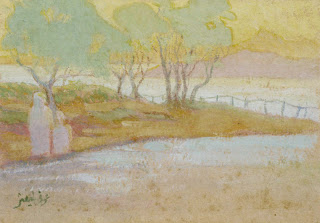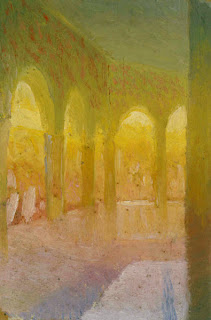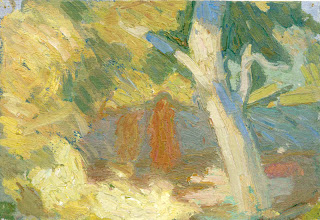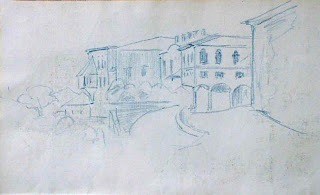Avni Lifij, who is one of the main figures in Turkish painting, has the characteristics of a typical Constitutional Period artist. In fact, as a result of a historical coincidence, 1908 is both the year when the Second Constitution was declared and the year when Avni Lifij proved his artistic level through his self-portrait. The year of his death, 1927, is the year, when the first generation of artists who had been sent to western countries in the beginning of the Republican Era, returned to the country bringing new knowledge and outlook.
Even though impressionism which is considered as the style of the Second Constitutional Period continued after 1927 through the Union of Fine Arts, and left behind a few positively high level works of art, its decline was observed after 1927.
When discussing the art of Avni Lifij, one has to ask what was the style of art adopted by the painters of the Constitutional Period and how did it developed? Before discussing this point we have to consider the idea of "national identity" which dominated the intellectual circles to which Avni Lifij belonged. In the Ottoman Empire the concept of "national identity" became the dominant ideology only after the reforms of 1908. Until this period first Islam and then the concept of Ottomanism was used as the unifying element for the different factors, which made up the Empire. But it became obvious that these concepts were not sufficient to unify the Ottoman Empire which had a multinational structure composed of different nations and ethnic groups. Although the ideas of nationalism and liberalism, which were the legacies of the French Revolution, were introduced to the Ottoman Empire during the Tanzimat Period, the legal rights based on these principles were realised during the Second Constitutional Period.
The Turkish painter Cemal Tollu points out that the artists of this period differed from those of the previous era in ethics and ideology. The outstanding ideologies of nationality and freedom, which dominated the intellectual and social life of that period, manifested itself in the contemporary art as well. The artists no more signed their work using the prefix "his Majesty's subject". They were no more dominated by the tastes of the palace and benefiting from this more liberal atmospheres they founded associations and unions. As a result, the first organisation in Turkish Arts the "Ottoman Painter Society" was founded and started a publication under the same name. However this group of painters actually functioned as a bridge between the western art and traditional Ottoman Art. While bringing in the new techniques and approach, they did not and could not cut themselves entirely from the past. They were inclined to merge impressionism with their own ideas. Hüseyin Avni Lifij, who was not a member of the "Ottoman Painters Society", took part in its activities from time to time, shared its feelings and ideas, and does maintain the characteristics of a Constitutional Period artist.
The Constitutional Period generation, when applying impressionism seems to have no clear idea about dealing with the human figure within this concept. They did not make any methodic efforts to leave aside the style of the Academic and Realistic Schools which they had studied first in Ottoman Turkey and later in Paris. This is true for most of the works of Avni Lifij as well as Çalli, Ruhi, Hikmet Onat and Sami Yetik. The small figures that blend with the landscape by the help of easy brush strokes as in the works of Claude Monet and Sisley, have been used to a great extend by the Constitutional Period generation. The small figure, which melts away with touches of colour and light, can be observed in the pochades of Namik Ismail, Çalli and Avni Lifij. When the artist of the Constitutional Period chooses a single figure as the subject or wants to realise a composition of many figures, he applies the methods of Academic-Realistic School. It would have been impossible for the artist who is anxious to be faithful to soundness of design in his drawings when dealing with the human figure, to have a different understanding. The human figure, which changed with the new concept of impressionistic composition in the hands of such artists as Renoir, Degas and Manet, had no impact on Ottoman painting. However the answer to the problem came again from the west, but from the style of Paul Chabat, Cormon, Cabanel or other academists. Years later, the solution was found by Turkish artists who gained new concepts through their deep interest in Cezanne, thereby liberating themselves from the academic methods, when dealing with the human figure.
The facts stated above have many examples in Turkish painting. Two of the most interesting examples on this subject are Avni Lifij's "Allegory" and "Kalkinma" which was originally titled "Belediye Faaliyetleri". In painting "Allegory" or originally "Harp Alegorisi" (>), the main figures which make up the structure of the painting are nudes or semi-nudes, one old and two young women and in the rear plane, a man. The disaster of war is obvious in the facial expressions and gestures of the figures. This style is quite different from the compositions of Çalli, Ali Cemal, Ruhi and Hikmet of the 1917 Sisli Studio*. While the above artists represent the human figure in their war and after the war paintings in a manner, which does not contradict the main theme, Avni Lifij puts nude or semi-nude figures in the battleground. This is quite in harmony with the objective of the artist, which is to express reality in symbols. Adding a symbolistic form and colours reminding one of Orientalism is doubtlessly one of the most characteristic aspects of the artist's this type of work. The artist painted "Belediye Faaliyetleri" which dimensionally is one of the biggest works of Turkish painting in 1916. This painting, in which he uses decorative and post-impressionistic methods, to express an everyday theme with an abundance of figures, is modernistic rather than academic in style.
As for the drawings of Avni Lifij on the human figure, which were realised under the downward inclined light of the traditional art studio, they contain sound plastic values which aim to give correctly such concepts as character, proportion, volume and plane, depth and distance by means of light and shade. The artists, besides these Academic drawings, have a large number of drawings of different style. Undoubtedly these studies which are not based on mere observation are poetic products which emerge from the depths of his character. The poetry in these works is not a planned manifestation, it is spontaneous. This spontaneity leads him to a high level of sensitivity, which protects him from artificial and superficial literary demonstrationalism. The painting which I titled "Romantik Bakisli Kadin" in the catalogue, we prepared for the exhibition in 1968 is a very good example of this. Even though the construction of human figure in the drawings of Hüseyin Avni Lifij may originate from the nature as in the academic style, it is enriched by a deep spiritual insight. Material realities combine with a melancholic outlook in his works. We can easily say that among the artists of the Constitutional Period there are no others who can better reflect their spiritual world into their work. As we know, impressionism is interested in the transformation of outside realities and tries to place these physical manifestations on a scientific platform, without damaging the instinctive sensations but reinforcing them. Lifij, who benefited from the impressionistic doctrine from time to time, presents the products of an artist, which puts more weight on the spiritual than the visual. From this point of view it is probably easy to find similarities to Symbolists in his works.
Here we quote from a critique of the exhibition he opened on March 3,1918 in the offices of the French daily Orient Litteraire published in Istanbul, in order to give an evaluation of the ideas of the day. The writer says, "Avni Bey has a characteristic style which is a very scientific, patient and painstaking search for expression and colour aimed to depart from nature, made commonplace by being copied by numerous inferior circles. Avni does not try to please bourgeois tastes as seen in photographic portraits or enlarged postcards. He does not copy nature, he corrects it, embellishes nature with a spirit which it does not posses." The critique speaks of Lifij's large scale paintings which emphasise his power of creation, but he also adds, "his real work is in his drawings."
A part of Lifij's drawings reflect general and detailed landscapes from Istanbul and other places. The artist who enframed varied planes of distance according to the requirement of the subject such as groups of houses, narrow streets and copses into his drawings, after passing them trough the sieve of his knowledge, experience and sensibility, also made exact drawings of historical structures in his documental work. Hüseyin Avni Lifij who returned to his country in 1912, completed a series of drawings, the characteristics of which are given below, until the year 1916. These drawings which have been produced under a rigid discipline can be divided into two main groups according to their characteristics as to the design and colour.
An example of the second category, trees, which have been emphasised by silhouettes, make us think they may be sketches for future work or drawings for a painting. In these works the aim is to present values stripped of their details, in softer contours and a free style. This change in attitude will be observed also in his paintings where sensibility comes foremost. It is very natural that landscapes could not restrict the work of an artist who can solve so many technical problems. As a matter of fact his self-portrait drawn in 1916 is a representative work where the silhouette is dominant with emphasised sensibility and colour characteristics.
His pochades, the subject of this book, mean small size oil sketches painted outdoors. These instantaneous pieces of work, which are works of art by themselves in many cases, were probably preparatory sketches for a larger scale painting.
In Ottoman Turkey work on pochade starts after contact with impressionism. If we leave aside Seker Ahmet Pasa and Süleyman Seyyid who have been trained in Europe, artists such as Halil Pasa and Hoca Ali Riza who have fought against methods of copying models or photographs, preferred to paint directly from nature both indoors and out, and produced outdoor pochades. This process was later adopted by Sami Yetik, Avni Lifij and Namik lsmail.
It is very interesting that this outdoor (Plenerist) method of pochade work has been considered a necessary method of impressionism in Turkey. Such studies which can retain the freshness and liveliness of nature were executed in small sizes because of the ease of carrying and working and since they were considered as preparatory sketchings for a larger painting, their qualifications as works of art was not important for the artist, he considered them as his tools. In this way he could sketch the whole or a detail of his future painting in a short time. The Artist's wife, Harika Sirel Lifij, tells us, that Hüseyin Avni was planning to use his pochades in larger scale paintings. Probably this is not true for all of the pochades, but as seen in this book, it is quite possible that some of them were sketchings in preparation for a larger scale work. Here we should remember that the foremost characteristics of the pochades are the use of colour. When a pochade is transferred into a larger scale painting this free use of colour may be altered during the development of the work in order to adopt colour to the form.
Even though there are many problems to be solved concerning the painting of the Constitutional Period, we still think it is necessary to give great importance to these exceptional pochades. Putting together the works of our pochade painters will not only be a valuable collection of their work, but will also show us the surprising fact that these artists were much more courageous in their pochades in comparison to their other work, and in them showed an artistic development quite beyond their period. Some of the pochades presented in this book (pages 108 and 109) have qualifications which would cause the envy of those modern artists who work in the same style.
Pochades are examples of Lifij's ability to combine, blend and harmonise colour and form in brilliant light and utmost simplicity, and his ability to choose and interpret his subject in a short time.
The pochades of Avni Lifij are works in which the artist, sometimes, can keep his sensitivity in balance when in dialogue with the nature, and sometimes lets his emotions lead the way. We can witness his accumulation of culture and experience in almost all of these works, and besides the above characteristics of his work, it is obvious that he can adopt a new harmony and a new order of plastic ideas when faced with the nature.
* Sisli Studio was established during the First World War (1917) at Sisli, a prosperous quarter of Istanbul, under the orders of the minister of war, Enver Pasa, and it survived for a year. The aim of this studio was to enable Turkish artists to execute compositions on war, and to exhibit the resulting works abroad. Artists such as Ibrahim Çalli, Mehmet Ruhi, Ali Cemal, Namik Ismail, Sami Yetik, Hikmet Onat and Ali Sami Boyar who had an important place in Turkish painting art, later on, worked in this studio. Crown Prince Abdulmecit was among the people who visited this studio. He talked with the artists and attended discussions on art.
Avni Lifij did not participate in the activities of this studio, but contributed 18 paintings to an exhibition of Turkish paintings on war and various other subjects, which opened at Vienna University in 1918.
Avni Lifij did not participate in the activities of this studio, but contributed 18 paintings to an exhibition of Turkish paintings on war and various other subjects, which opened at Vienna University in 1918.
Translated by Güner Çilesiz
























































































.JPG)
.JPG)


























.JPG)












































































































0 comments:
Post a Comment